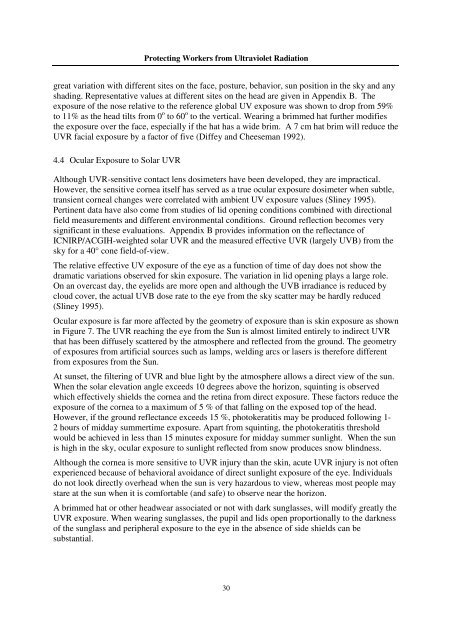Protecting Workers from Ultraviolet Radiation - icnirp
Protecting Workers from Ultraviolet Radiation - icnirp
Protecting Workers from Ultraviolet Radiation - icnirp
Create successful ePaper yourself
Turn your PDF publications into a flip-book with our unique Google optimized e-Paper software.
<strong>Protecting</strong> <strong>Workers</strong> <strong>from</strong> <strong>Ultraviolet</strong> <strong>Radiation</strong><br />
great variation with different sites on the face, posture, behavior, sun position in the sky and any<br />
shading. Representative values at different sites on the head are given in Appendix B. The<br />
exposure of the nose relative to the reference global UV exposure was shown to drop <strong>from</strong> 59%<br />
to 11% as the head tilts <strong>from</strong> 0 o to 60 o to the vertical. Wearing a brimmed hat further modifies<br />
the exposure over the face, especially if the hat has a wide brim. A 7 cm hat brim will reduce the<br />
UVR facial exposure by a factor of five (Diffey and Cheeseman 1992).<br />
4.4 Ocular Exposure to Solar UVR<br />
Although UVR-sensitive contact lens dosimeters have been developed, they are impractical.<br />
However, the sensitive cornea itself has served as a true ocular exposure dosimeter when subtle,<br />
transient corneal changes were correlated with ambient UV exposure values (Sliney 1995).<br />
Pertinent data have also come <strong>from</strong> studies of lid opening conditions combined with directional<br />
field measurements and different environmental conditions. Ground reflection becomes very<br />
significant in these evaluations. Appendix B provides information on the reflectance of<br />
ICNIRP/ACGIH-weighted solar UVR and the measured effective UVR (largely UVB) <strong>from</strong> the<br />
sky for a 40° cone field-of-view.<br />
The relative effective UV exposure of the eye as a function of time of day does not show the<br />
dramatic variations observed for skin exposure. The variation in lid opening plays a large role.<br />
On an overcast day, the eyelids are more open and although the UVB irradiance is reduced by<br />
cloud cover, the actual UVB dose rate to the eye <strong>from</strong> the sky scatter may be hardly reduced<br />
(Sliney 1995).<br />
Ocular exposure is far more affected by the geometry of exposure than is skin exposure as shown<br />
in Figure 7. The UVR reaching the eye <strong>from</strong> the Sun is almost limited entirely to indirect UVR<br />
that has been diffusely scattered by the atmosphere and reflected <strong>from</strong> the ground. The geometry<br />
of exposures <strong>from</strong> artificial sources such as lamps, welding arcs or lasers is therefore different<br />
<strong>from</strong> exposures <strong>from</strong> the Sun.<br />
At sunset, the filtering of UVR and blue light by the atmosphere allows a direct view of the sun.<br />
When the solar elevation angle exceeds 10 degrees above the horizon, squinting is observed<br />
which effectively shields the cornea and the retina <strong>from</strong> direct exposure. These factors reduce the<br />
exposure of the cornea to a maximum of 5 % of that falling on the exposed top of the head.<br />
However, if the ground reflectance exceeds 15 %, photokeratitis may be produced following 1-<br />
2 hours of midday summertime exposure. Apart <strong>from</strong> squinting, the photokeratitis threshold<br />
would be achieved in less than 15 minutes exposure for midday summer sunlight. When the sun<br />
is high in the sky, ocular exposure to sunlight reflected <strong>from</strong> snow produces snow blindness.<br />
Although the cornea is more sensitive to UVR injury than the skin, acute UVR injury is not often<br />
experienced because of behavioral avoidance of direct sunlight exposure of the eye. Individuals<br />
do not look directly overhead when the sun is very hazardous to view, whereas most people may<br />
stare at the sun when it is comfortable (and safe) to observe near the horizon.<br />
A brimmed hat or other headwear associated or not with dark sunglasses, will modify greatly the<br />
UVR exposure. When wearing sunglasses, the pupil and lids open proportionally to the darkness<br />
of the sunglass and peripheral exposure to the eye in the absence of side shields can be<br />
substantial.<br />
30



